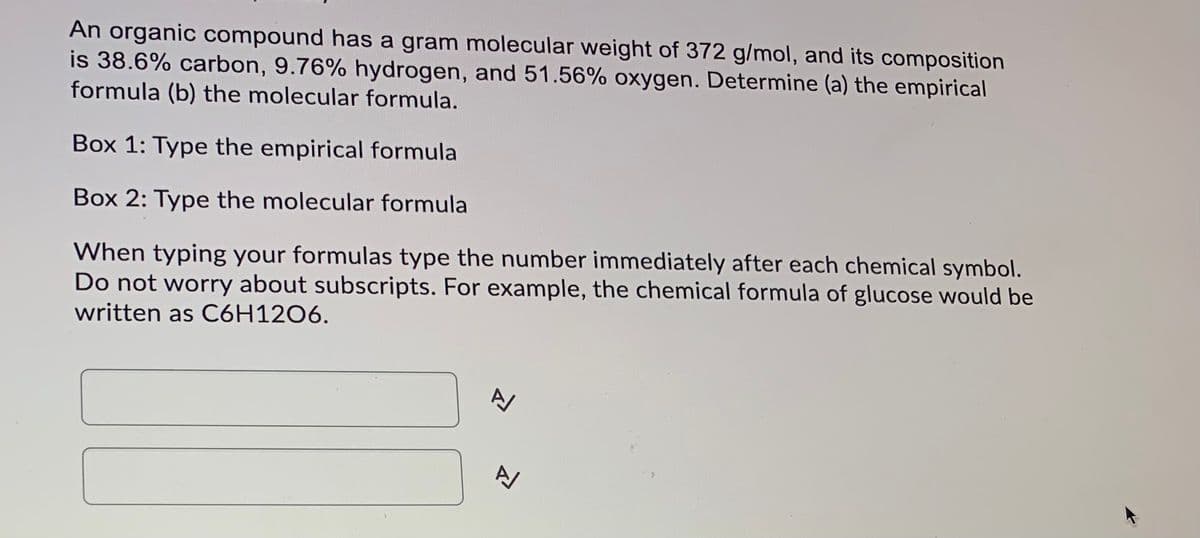rgahic compound has a gram molecular weight of 372 g/mol, and its composition is 38.6% carbon, 9.76% hydrogen, and 51.56% oxygen. Determine (a) the empirical formula (b) the molecular formula. Box 1: Type the empirical formula Box 2: Type the molecular formula When typing your formulas type the number immediately after each chemical symbol. Do not worry about subscripts. For example, the chemical formula of glucose would be written as C6H1206.
rgahic compound has a gram molecular weight of 372 g/mol, and its composition is 38.6% carbon, 9.76% hydrogen, and 51.56% oxygen. Determine (a) the empirical formula (b) the molecular formula. Box 1: Type the empirical formula Box 2: Type the molecular formula When typing your formulas type the number immediately after each chemical symbol. Do not worry about subscripts. For example, the chemical formula of glucose would be written as C6H1206.
Chemistry & Chemical Reactivity
9th Edition
ISBN:9781133949640
Author:John C. Kotz, Paul M. Treichel, John Townsend, David Treichel
Publisher:John C. Kotz, Paul M. Treichel, John Townsend, David Treichel
Chapter2: Atoms Molecules And Ions
Section: Chapter Questions
Problem 129GQ: Empirical and molecular formulas. (a) Fluorocarbonyl hypofluorite is composed of 14.6% C, 30.0% O,...
Related questions
Question
100%

Transcribed Image Text:An organic compound has a gram molecular weight of 372 g/mol, and its composition
is 38.6% carbon, 9.76% hydrogen, and 51.56% oxygen. Determine (a) the empirical
formula (b) the molecular formula.
Box 1: Type the empirical formula
Box 2: Type the molecular formula
When typing your formulas type the number immediately after each chemical symbol.
Do not worry about subscripts. For example, the chemical formula of glucose would be
written as C6H12O6.
Expert Solution
This question has been solved!
Explore an expertly crafted, step-by-step solution for a thorough understanding of key concepts.
This is a popular solution!
Trending now
This is a popular solution!
Step by step
Solved in 3 steps with 3 images

Knowledge Booster
Learn more about
Need a deep-dive on the concept behind this application? Look no further. Learn more about this topic, chemistry and related others by exploring similar questions and additional content below.Recommended textbooks for you

Chemistry & Chemical Reactivity
Chemistry
ISBN:
9781133949640
Author:
John C. Kotz, Paul M. Treichel, John Townsend, David Treichel
Publisher:
Cengage Learning

Chemistry & Chemical Reactivity
Chemistry
ISBN:
9781337399074
Author:
John C. Kotz, Paul M. Treichel, John Townsend, David Treichel
Publisher:
Cengage Learning

Principles of Modern Chemistry
Chemistry
ISBN:
9781305079113
Author:
David W. Oxtoby, H. Pat Gillis, Laurie J. Butler
Publisher:
Cengage Learning

Chemistry & Chemical Reactivity
Chemistry
ISBN:
9781133949640
Author:
John C. Kotz, Paul M. Treichel, John Townsend, David Treichel
Publisher:
Cengage Learning

Chemistry & Chemical Reactivity
Chemistry
ISBN:
9781337399074
Author:
John C. Kotz, Paul M. Treichel, John Townsend, David Treichel
Publisher:
Cengage Learning

Principles of Modern Chemistry
Chemistry
ISBN:
9781305079113
Author:
David W. Oxtoby, H. Pat Gillis, Laurie J. Butler
Publisher:
Cengage Learning

Chemistry: An Atoms First Approach
Chemistry
ISBN:
9781305079243
Author:
Steven S. Zumdahl, Susan A. Zumdahl
Publisher:
Cengage Learning


Chemistry
Chemistry
ISBN:
9781305957404
Author:
Steven S. Zumdahl, Susan A. Zumdahl, Donald J. DeCoste
Publisher:
Cengage Learning